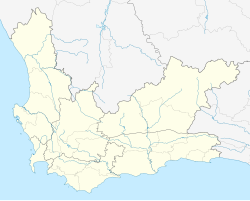Robbin Island
|
Robben Island Robbeneiland |
|
|---|---|

Robben Island Village
|
|
|
|
|
| Coordinates: 33°48′24″S 18°21′58″E / 33.806734°S 18.366222°ECoordinates: 33°48′24″S 18°21′58″E / 33.806734°S 18.366222°E | |
| Country | South Africa |
| Province | Western Cape |
| Municipality | City of Cape Town |
| Area | |
| • Total | 5.18 km2 (2.00 sq mi) |
| Population (2011) | |
| • Total | 116 |
| • Density | 22/km2 (58/sq mi) |
| Racial makeup (2011) | |
| • Black African | 60.3% |
| • Coloured | 23.3% |
| • White | 13.8% |
| • Other | 2.6% |
| First languages (2011) | |
| • Xhosa | 37.9% |
| • Afrikaans | 35.3% |
| • Zulu | 15.5% |
| • English | 7.8% |
| • Other | 3.4% |
| PO box | 7400 |
| Type | Cultural |
| Criteria | iii, vi |
| Designated | 1999 (23rd session) |
| Reference no. | 916 |
| State Party | South Africa |
| Region | Africa |
Robben Island (Afrikaans: Robbeneiland) is an island in Table Bay, 6.9 km west of the coast of Bloubergstrand, Cape Town, South Africa. The name is Dutch for "seal island." Robben Island is roughly oval in shape, 3.3 km long north-south, and 1.9 km wide, with an area of 5.07 km². It is flat and only a few metres above sea level, as a result of an ancient erosion event. Nobel Laureate and former President of South Africa Nelson Mandela was imprisoned there for 18 of the 27 years he served behind bars before the fall of apartheid. To date, three of the former inmates of Robben Island have gone on to become President of South Africa: Nelson Mandela, Kgalema Motlanthe, and current President Jacob Zuma.
Robben Island is a South African National Heritage Site as well as a UNESCO World Heritage Site.
Since the end of the 17th century, Robben Island has been used for the isolation of mainly political prisoners. The Dutch settlers were the first to use Robben Island as a prison. Its first prisoner was probably Autshumato in the mid-17th century. Among its early permanent inhabitants were political leaders from various Dutch colonies, including Indonesia, and the leader of the mutiny on the slave ship Meermin.
After the British Royal Navy captured several Dutch East Indiamen at the battle of Saldanha Bay in 1781, a boat rowed out to meet the British warships. On board were the "kings of Ternate and Tidore, and the princes of the respective families". The Dutch had long held them on "Isle Robin", but then had moved them to Saldanha Bay.
...
Wikipedia




